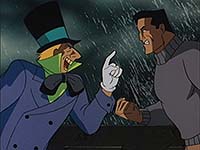|
||
|
| Credits | Cast | |
Story by Laren Bright & Michael Reaves Teleplay by Joe R. Lansdale Directed by Boyd Kirkland Music by Shirley Walker Animation by Dong Yang |
Kevin Conroy as Bruce Wayne Efrem Zimbalist Jr. as Alfred Bob Hastings as Commissioner Gordon Adrienne Barbeau as Selena Kyle |
Diana Muldaur as Dr. Leslie Thompkins Roddy McDowell as The Mad Hatter Brian Cummings as Reporter |
|
(1) It gives us a masterful dramatization of the old philosophical questions "What is real?" and "What can you know?"; the Hatter's Looking Glass -inspired soliloquy only confronts us with questions we should have been asking all along. Central to the story is Wayne's refusal to be taken in: "It's not real," he insists of the dream universe. "It's all a lie!" But even if he finds the truth in the midst of all the lies, how is he going to recognize it? Consider his session with "Leslie": She tells him he is suffering from "disassociation," but since she is only a figure in the dream, what she says cannot be trusted as true. But now look at "the Hatter," who tells him he is trapped inside "a very special dream." Since this character, by his own admission, is also only a figure in the dream, what he says cannot be trusted either. So why should Wayne think the Hatter's explanation is more likely to be true than Leslie's? Of course, Wayne thinks he's found an independent way of testing his hypothesis (printed words don't make sense in a dream and they don't make sense here) but that won't confirm the Hatter's explanation, because it falls victim to the same problem. That is, being itself, by hypothesis, only a part of the dream world, that test cannot be trusted any more than can Leslie or the Hatter. Put it this way: Even after Wayne thinks he's escaped, the problem will follow—has he escaped the dream, or only dreamed that he's escaped, and is now trapped in another dream (one in which printed words do make sense)? Given that he might never be able to tell the difference between the real and the delusive, how could he ever prove to himself that he has finally escaped into the "real" reality? "There is no way out of this," the Hatter asserts of Wayne's situation. He was speaking of escape from the dream, but might also have so spoken of escape from the epistemic predicament the dream machine raises. (2) The psychological interplay between the two sides of our hero's personality gets its hardest workout; the delirious fight between Bruce Wayne and Batman atop the cathedral only scratches the surface. Without his alter-ego, Wayne is bored and boring. The speed with which he falls into the patterns set by the delusive universe suggest that the weaknesses alluded to by Alfred—laziness and dilettanteism—are genuine traits of that part of his character. And why does he attack Batman at the end? Having recognized the world as a delusion, does he blame his Batman persona for getting him into this mess? ("You did this to me!" he shouts accusingly at the cloaked figure.) After all, when he unmasks the figure, it turns out to be one of his traditional adversaries; is Wayne holding Batman to be an enemy, of a kind with the Hatter? On the other hand, might the fight be an expression of resentment and jealousy of a clearly superior side of the personality? "Leslie" diagnoses Bruce's delusions as rooted in envy of someone who has attained stature through deeds, not wealth. If she speaks as a part of his psyche—if Wayne/Batman is analyzing himself inside this dream—then perhaps there is more to this duality than we have realized. Perhaps Batman is not just the mantle of "dark knight" assumed for the sake of justice, but is also the fantasy life of a rich playboy who is, or would be, bored with parties, gossip and political power. By jumping from the tower, after all, Wayne clearly expresses a desire to depart any world in which he is not Batman.
(4) Small but telling touches. Batman's split identity is illustrated with mirrors. The sign above a jewelry store is gibberish, long before the inability to read becomes important. The Hatter's theme, played by the brass (traditionally Batman's section), appears during the fight scene atop the cathedral, even before "Batman" is revealed to be the Hatter. Such touches, as the series' makers know, add immeasurably to the texture of the story. |
|
Production Notes Bruce Timm: "In the recording session, we had to push [Roddy McDowall]. We told him he had to be more angry. He couldn't quite do it. We finally told him to go as far as he could go. Take it way over the top. Way over what he normally would do if he was in a theater. With that he gave us the intensity we wanted." |
|
Related Episodes |
What Others Are Saying ... |
| Back to Paging the Crime Doctor |
Forward to P.O.V. |



